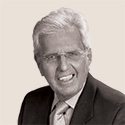Units and Executives Shift at Enlarged Jacobs and SNC-Lavalin
In first-quarter 2018 results announced on Feb. 7, Jacobs Engineering Group Inc., Dallas, reported revenue up about 8%, through organic growth and from its acquisition of CH2M, which closed Dec. 15. Wall Street construction sector analyst Jamie Cook, a managing director at Credit Suisse, said in a research note that “the top line surprise” was driven by the firm’s higher-margin technology and buildings segments, but Jacobs CEO Steve Demetriou also noted “modestly improved fundamentals” in its petroleum, chemicals and mining markets.

The Jacobs-only backlog in the quarter ending Dec. 29 was “relatively flat” at $19.6 billion versus record highs in prior quarters, Cook said, but it still rose by $1.4 billion compared with Q1 in 2017. The firm’s “balance sheet is in better shape” than expected, she added, with net debt of $1.5 billion compared with an expected $1.9 billion after the CH2M deal closing. Andrew Wittmann, industry sector analyst at Baird Equity Research, said CH2M met Jacobs’ internal operating cash flow targets for the year “and employee engagement seems to be holding.”
With the Jacobs-CH2M integration, the new parent announced executive changes in its “simplified operating model” of three global business lines. Terrence D. Hagan was named to lead its new aerospace, technology, environmental and nuclear unit; he was president of Jacobs’ aerospace and technology unit. Robert Pragada will lead the firm’s new buildings, infrastructure and advanced facilities business; he was in a similar role previously at the firm. Vinayak Pai, who now is president of Jacobs’ energy, chemicals and resources unit, was interim head of its global petroleum and chemicals business. The firm will report results by those business lines by spring, it said.
Jacobs also said earlier this month it sold its 41% stake in Mission Support Alliance, a U.S. Energy Dept. contractor at the Hanford nuclear site in Washington state, to Leidos for an undisclosed sum. The sale was mandated because of DOE conflict-of-interest rules that were triggered by Jacobs’ ownership of CH2M Plateau Remediation Co., which has a $4.5-billion cleanup contract at Hanford over 10 years.
As of Jan. 1, executive changes took effect at SNC-Lavalin Group Inc., Montreal, following its 2017 acquisition of U.K.-based Atkins. Named to head the combined firms’ work in oil and gas sectors is Christian Brown. He joined SNC-Lavalin in 2014, when it acquired Kentz Corp., of which he had been CEO. Nick Roberts, formerly CEO of Atkins’ U.K. and European business, now is president of the parent firm’s engineering, design and project management group. He will oversee infrastructure engineering globally, except in Canada. Sandy Taylor now leads the combined Atkins-SNC-Lavalin nuclear power business to include consulting, EPCM work, technology services, reactor support and decontamination and decommissioning. He previously led that work for SNC-Lavalin. Also, Marie-Claude Dumas is named president of a new clean power business unit to include hydro, transmission and distribution, renewables and energy storage. Most recently, she was corporate executive vice president of human resources and, previously, EVP of the hydro unit.
Peter “Andi” Vigue has been elevated to CEO of The Cianbro Cos. In that role he succeeds his father, Peter “Pete” Vigue, who remains chairman of the Pittsfield, Maine, nonunion contractor. The younger Vigue had been president and chief operations officer of Cianbro Corp. Pete Vigue, a 48-year Cianbro veteran, was CEO since 2000. The firm ranks at No. 103 on ENR’s Top 400 U.S. contractors list.
Lowell, Mass., design firm TRC Cos. has hired Michael Koski as senior vice president of a new Canadian business. Formerly the U.S.-located senior vice president of energy services at exp Global, he now will be based in a Canada location TRC did not confirm.
Derya Thompson has joined engineer Thorton Tomasetti as a senior vice president and U.S. Western region transportation practice leader. She was director of complex bridges and structures at Jacobs Engineering Group, working on the California High Speed Rail project. Thompson also had led Arup’s Americas bridge-civil structures practice.
David Johnson has joined SERA Architects, San Mateo, Calif., as a principal. He had been partner and managing director at William McDonough + Partners.
Paul H. Mueller, 89, regarded by peers as a pioneer in bridge cable design and erection, died on Nov. 24, 2017, in Fort Lauderdale, Fla., according to a Jan. 26 announcement from bridge design firm T.Y. Lin, which notes “his contributions to … modern suspension bridge construction.”

In his specialty, Mueller was instrumental in erecting main cables for the Lisbon Tagus River Bridge, Hong Kong’s Tsing-Ma Bridge, the Verrazano-Narrows Bridge in New York City and most recently, the San Francisco-Oakland Bay Bridge, says T.Y. Lin.
The firm says he advanced the controlled-tension method for spinning suspension bridge cables, a method he developed by observing ski lift systems.
Among construction sector businesses that Mueller launched was P. H. Mueller International Inc. in 1990, a Fort Lauderdale-based consulting firm that focused on construction erection procedures and equipment. He devised a replacement for the San Francisco-Oakland span that featured a continuous looping main cable for a self-anchored suspension bridge, according to T.Y. Lin.
“Paul basically put together on a drawing how to build the entire bridge,” says Marwan Nader, the design firm’s senior vice president and technical director.




